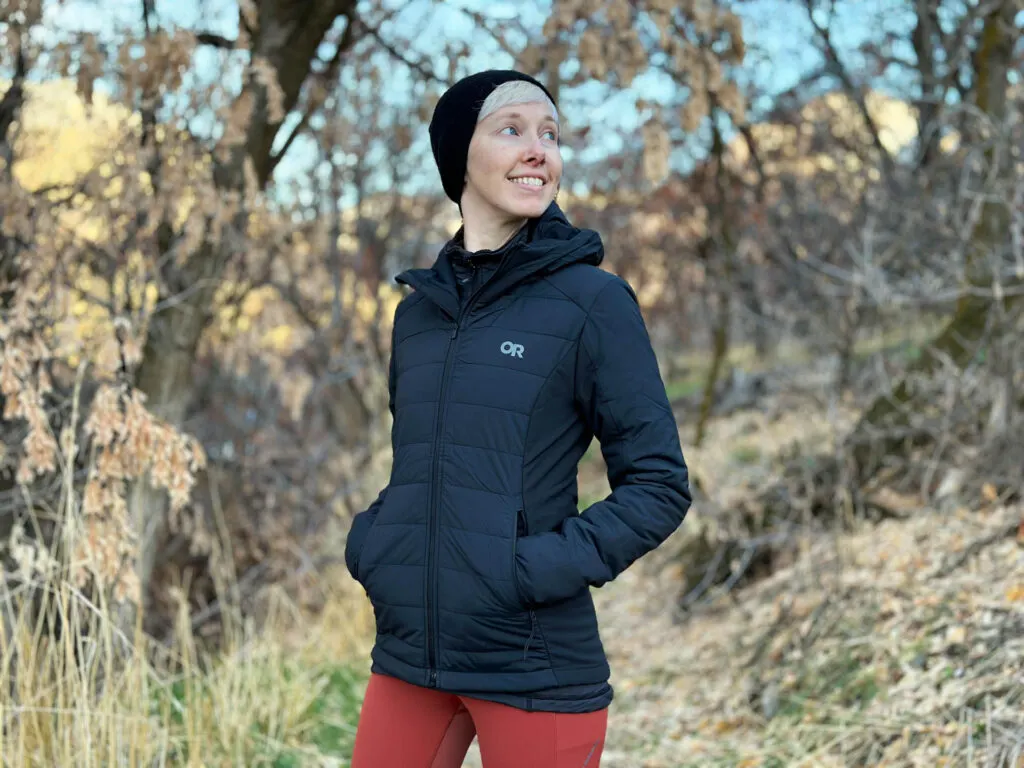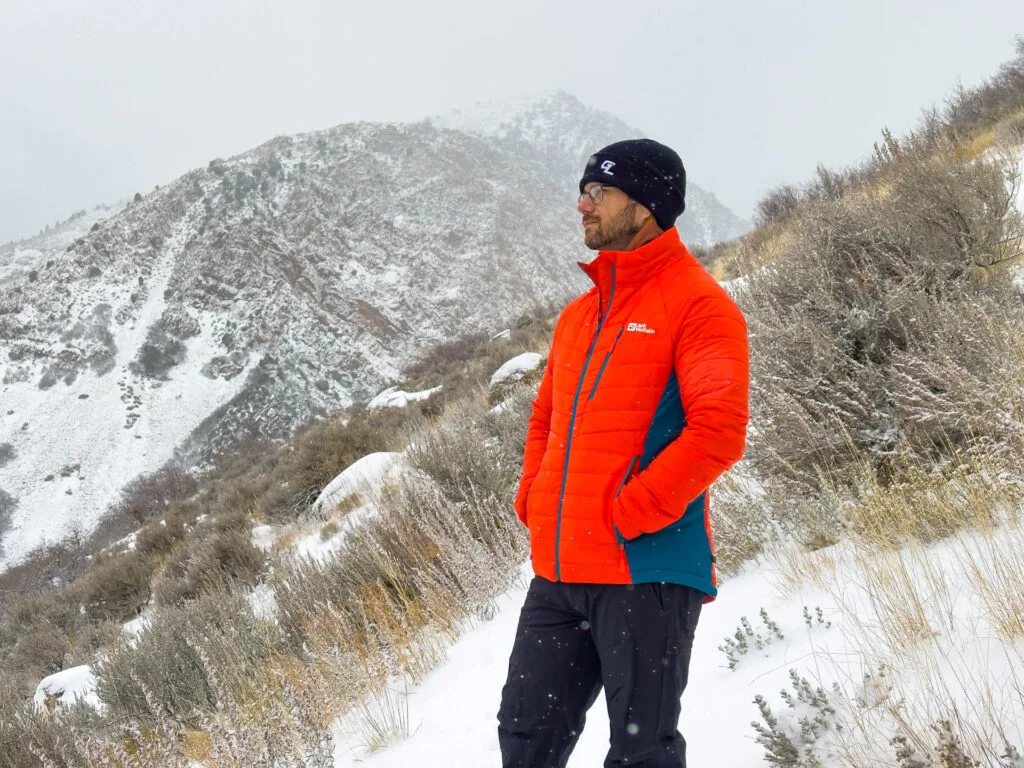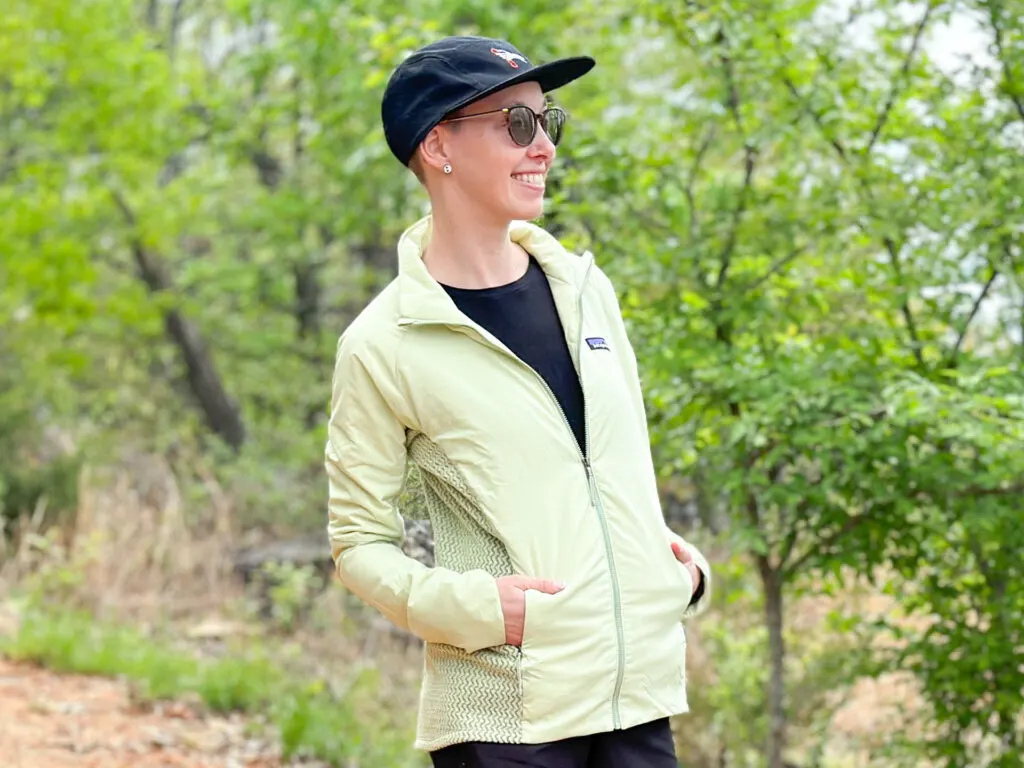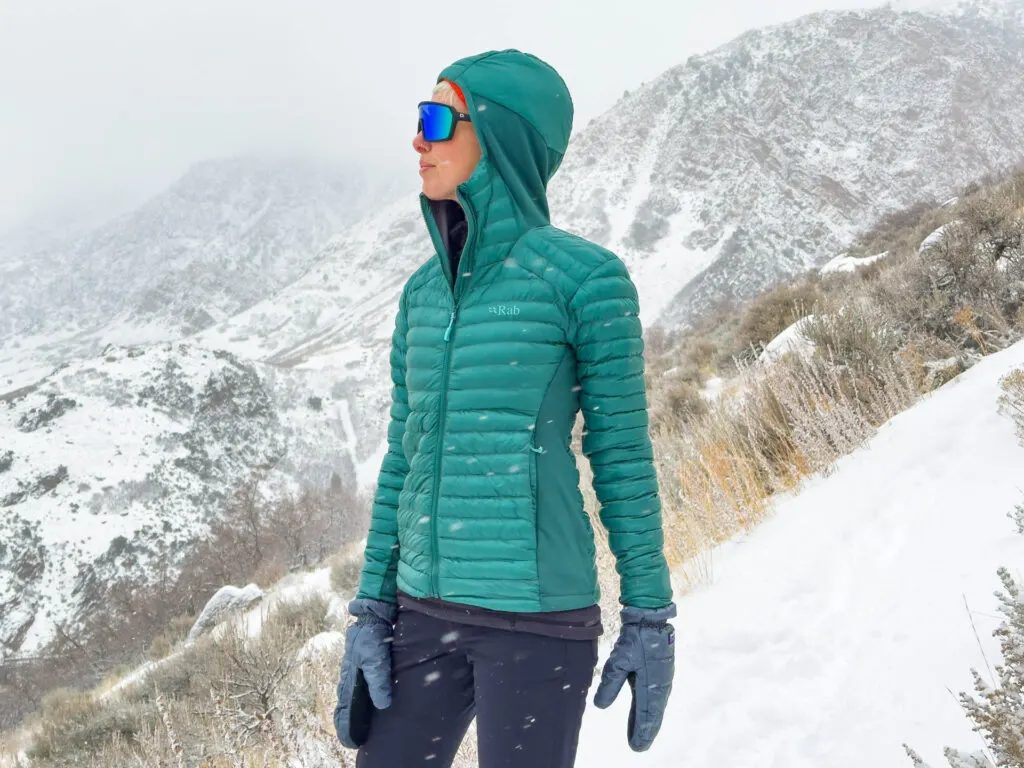Up to 50% Clearance Clothing & Footwear + Extra 25% Off REI Outlet.
Hybrid jackets. They’re a beautiful thing. You’ve got nice cozy insulation in the front, sometimes the back, exactly where you need it to keep you warm plus plenty of stretch on the sides or under the arms to aid in breathability and flexibility. It’s the best of both worlds: warmth and freedom of motion.
But why choose a hybrid jacket instead of a conventional insulated jacket? Where do hybrid jackets excel? Short answer: active pursuits. Long answer: Well, that really depends on the jacket, doesn’t it? But in general, hybrid jackets tend to be pretty dang versatile. For starters, those stretchy panels mean they make excellent midlayers during active pursuits (read more about the importance of layering in this post)
Why? Regular insulated jackets don’t tend to have any stretch, so when you’re wearing between 3-6 layers in the winter, all of it can feel incredibly restrictive and you tend to lose a fair amount of freedom of motion, which is no bueno when you’re climbing or skiing or backpacking. Heck, even hiking.
But hybrid jackets are also great as an external layer during cool weather or really high-output activities like trail running or uphill skinning or strenuous hiking in cold weather. They tend to breathe well, let you move however you need to, and are less bulky than more traditional insulators.
What they’re not as well suited for are wet-weather activities since they don’t tend to be as water resistant, or more stationary pursuits like sitting around the campground since they’re not insulated all around your arms and midsection.
Think you might benefit from a hybrid jacket? We reviewed 4 more sustainable jackets that are not only vegan, but also PFC-free (read more about PFC’s here). Huzzah!
Outdoor Research Shadow Hoodie II
The warmest, most durable, windproof option on the list is the Outdoor Research Shadow Insulated Hoodie II. It’s both water and wind resistant, has thumb holes (love), a bungee on the hem and the back of the hood, plus the insulation is made of a combo of recycled polyester and partially bio-based Sorona fabric, and the sides are made of a stretchy material that’s super soft and warm and fleecy on the inside. So dang cozy.
This has become my go-to jacket for really chilly active pursuits. It’s one of the most insulated of the bunch–by which I mean it’s thicker and heavier–and is an excellent quality jacket. The outer materials feel more durable than delicate, so that’s a pro for folks who tend to ride their gear hard, plus it has all the features you look for in a layer of this caliber.
The bungee on the insulated hood really helps it conform to the size and shape of your head, and the thumbs loops are obviously a win, especially if you’ll be wearing int on it’s own like I did for cold-weather runs. The hand pockets and chin guard are lined with a soft material that’s a really nice touch, very warm and cozy, but the drop pockets on the inside are super long and narrow, to the point where all that’s gonna fit in there is a pair of liner gloves at most. At least on the extra small. I’m sure it’s a more useful size on larger jackets.
The Shadow Hoodie is nice and fitted. I love how snug it is while still leaving enough room for a fitted layer or two underneath. It’s a great option for extra chilly trail runs or sunny cross country ski days or cool mornings at the crag. Activities where you’ll be working hard, but still need a little extra protection from the elements.
I will say, though, that the sleeves are very long. You can just yank them up, of course, but if you have long arms, take note: this might be the jacket for you. The arms are also fairly roomy compared to the torso.
But I want to talk about this Sorona fabric for a sec. The material’s website is pretty cryptic and probably can’t be deciphered by anyone without a chemical engineering degree–I do not have a chemical engineering degree–but from what I could find, the fabric is only 37% bio- or plant-based. The rest of it is still synthetic.
It uses 30% less energy and creates 50% less greenhouse gas emissions than conventional nylon, but I did a little digging and it seems like recycled nylon leaves an even lighter footprint–around 50% less energy and 50% fewer greenhouse gasses–so…I’m not sure I’m sold on this material being an innovation worth celebrating.
Available Sizes & Colors: Comes in S to XXXL for men but only XS to XL for women. Feels like we’re missing some size inclusivity there. It comes in a handful of colors, too.
Pros
- Warm
- Wind- and water-resistent
- Fitted
- Adjustable hood and hem
- Thumbholes
- Durable material
Cons
- Very long sleeves
- The sustainability of the new Sorona fabric seems suspect
Jack Wolfskin Routeburn Pro Insulated Jacket
The Routeburn Pro hybrid, hoodless jacket is an excellent option for a fitted midlayer and has an impressive amount of features for a jacket at this price point (it’s the most budget-friendly on this list). There are two zippered hand pockets PLUS a zippered chest pocket, which Josh thinks every jacket should have.
Another nice touch: soft fabric at the top of the zipper that acts as a chin guard and dual bungees on the waistband to really cinch it down if you need to. There’s a bit more room in the sleeves and body (at least in the men’s version), which allows space for slightly bulkier layers underneath.
It has a windproof and water resistant insulated material on most of the jacket body and sleeves, but the stretchy panels are just on the sides of this one, not down the arms or on the back, so if you need some give in the biceps or have really broad shoulders or something, you may want to size up, and it may not be the best option for climbers and those who require extra range of motion in the arms, but for hiking it’s a beauty.
In addition to being PFAS-free, it’s made with almost entirely recycled materials, including the synthetic insulation and stretchy fleece.
This one doesn’t feel quite as breathable as some other options on this list, but Josh says he’d definitely wear it on its own for moderate output activities like cool-weather hikes, leisurely cycling, that sort of thing, in addition to slower-paced activities like just wandering around town, camping, etc.
Plus, it cuts a flattering silhouette.
Honestly, the fabrics and materials don’t feel quite as premium as some of the other options on this list, but this is also the most affordable of the bunch, so if that’s a concern, definitely give the Routeburn Pro a go.
Available Sizes & Colors: It comes in quite a few colors for men and women, including some very vibrant hues. It’s available in XS to XXL for women and S to XXL for men.
Pros
- Budget-friendly
- Bold colors
- More insulation in the arms for warmth
- Lots of pockets
- Adjustable hem
- Hoodless design and slick fabric perfect for layering
Cons
- Material doesn’t seem as high quality
- Slightly less breathable than other options
The Patagonia Nano-Air Light Hybrid Jacket
Materials-wise, The Patagonia Nano-Air Light Hybrid Jacket might be my favorite, mostly because the front and sleeve fabric is buttery soft (though won’t be quite as durable as some of these other options, I think). It’s also insulated for warmth while the entire back panel and underside of the arms is a super stretchy, soft and breathable fleece.
All of the jacket–except for a small percentage of the insulation–is made of completely recycled polyester and the shell has a PFC-free water repellent coating to help keep you dry in light rain.
I loved this one for uphill hiking and trail running. It fit seamlessly under a shell and over a synthetic tee. And while the insulation feels super lightweight and minimal, it actually kept me really warm on a trail run in thirty-five degree temps and blowing wind, even with as slow a runner as I am. I mean, I had it fully unzipped by mile 1.5. That’s how good of an insulator it is.
Is it the warmest on this list or the most windproof from all sides? Well, no, but if you’re looking for an excellent midlayer that feels like a sweater for really high-output pursuits, this may be the one for you. Bonus: it’s not hooded, which I like in a midlayer (though there is a hoody version).
And I never felt like my range of motion was inhibited. I mean, that fleece Air Wave material is impressively stretchy. The sleeves are a bit snug compared to the body of the jacket–at least in my opinion–but the whole thing is designed to be fitted, and the ample stretch offers plenty of wiggle room in the fit department.
I tested a size small, but an extra small would have been better for me, which is to say the jacket runs true to size, but size up if you plan to layer it over anything remotely bulky. A small left plenty of room when worn over a roomy grid fleece.
There aren’t a ton of additional features: just two hand pockets, no internal drop pockets or anything in the way of bungees, but I don’t have a problem with that.
Available Sizes & Colors: It’s available in several colors (though no longer this soft green) an in sizes XS to XXL in both women’s and men’s.
Pros
- Buttery fabric
- Tons of stretch
- Extremely breathable
- Super warm for its weight
- Comfortable
- No hood makes it great for layering
Cons
- Expensive
- Doesn’t feel as durable
- Not as many bells and whistles
Rab Cirrus Flex Insulated Hooded Jacket
So, spoilers, The Cirrus Flex might be my overall favorite jacket of the bunch. Mostly because it feels like wearing a cozy sweater. For real. But also because the proportions are just perfect. For me, at least. Obviously your experience may vary. But the sleeves are the perfect length, the body and sleeves were just the right amount of fitted, and frankly, it just cuts a flattering silhouette.
The side panels that extend down the arms offer the perfect amount of stretch and this thing didn’t feel restrictive at all under a shell or over a fitted base layer or two.
But maybe my favorite feature is the hood. Often, I don’t like hoods on mid layers because it’s easy when you’re layering to just get too many hoods piled up. But this hood is baller. It fits beautifully and stays put even without a bungee, AND has stretchy panels on the sides, which means not only can you pull it over your head with the jacket zipped all the way up, which you can’t do with most jackets, it also doesn’t restrict head movement. It just moves with you when you turn from left to right.
Plus it has nice tall zippered hand pockets so you can get into them even if you’re wearing a backpack with a hip belt or a harness, stash pockets on the inside, and a large section of soft fabric by your chin. It’s lightweight and the fabric is silky, and honestly, I would wear this around the house as a sweater in addition to a midlayer or active outer layer. And did I mention it can be packed into its own pocket?
The super silky down-like insulation is made of 100% recycled materials, as is the satiny outer and liner fabric–just not the fleece panels. Plus, it’s all PFC-free.
Available Sizes & Colors: This jacket comes in a ton of colors for women and men (Eucalyptus color pictured) and in XS to XXL for women and men.
Pros
- Fits like a glove
- Stretchy hood and panels
- Bungee in the hem
- Wears like a sweater
- Warm
- Soft to the touch
- Super flexible
Cons
- Not quite as durable as an outer layer (but we’re nit-picking, here…this is our fave of the bunch)
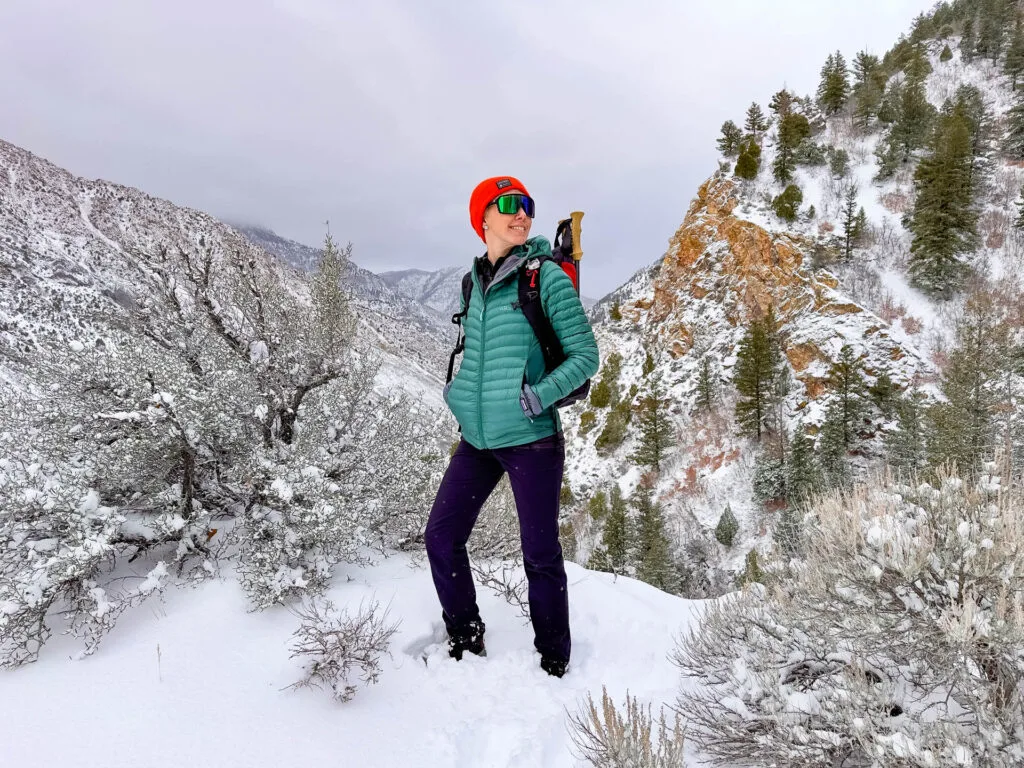
How to Pick the Right Size Jacket
Now, a note on sizing on all of these, especially if you’re ordering a women’s cut: they all run pretty true to size, but are designed to be worn over a fitted base layer or two. So if you think you’ll be layering these over bulkier items like a fleece sweater or something, size up.
Bottom Line
When it comes to updating your layers, remember, the truly sustainable choice is to repair and rewear the gear you already have before going out and buying something new. Or, try to find one of these jackets used (here are some of our favorite places to get used gear). Then take care of it, enjoy wearing the heck out of it for years to come, and get out there and wander on this season.
•
This post contains affiliate links, which means when you clicky-click and make a purchase, we may receive some compensation. Don’t worry, it won’t cost you any extra, but you will be supporting Terradrift! That’s what we call a win-win!
Alisha is a freelance outdoor journalist and photographer based in Ogden, UT. She loves backpacking, hiking, mountain biking, kayaking and snowboarding (even though she’s terrible at it). She’s also pretty sure she’s addicted to coffee. alishamcdarris.com

